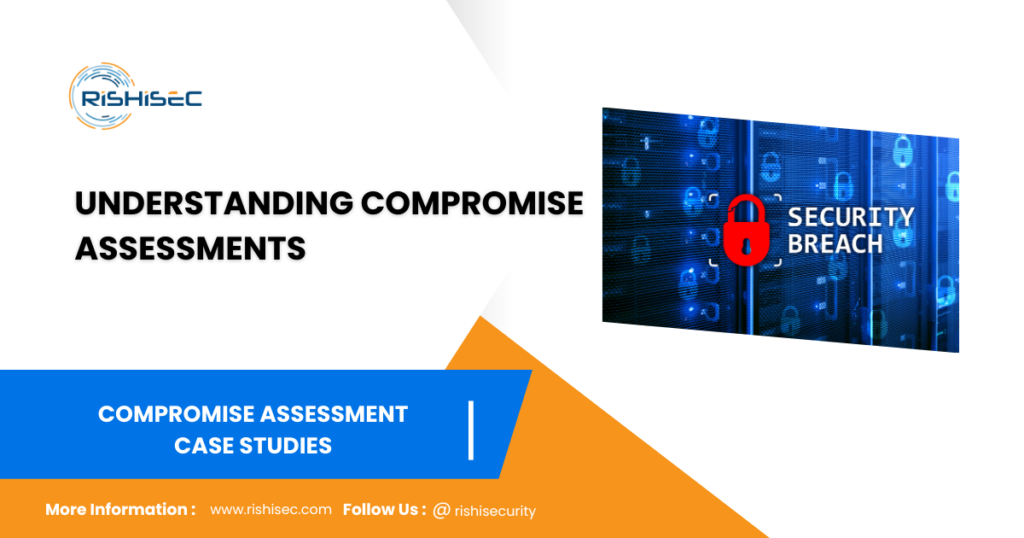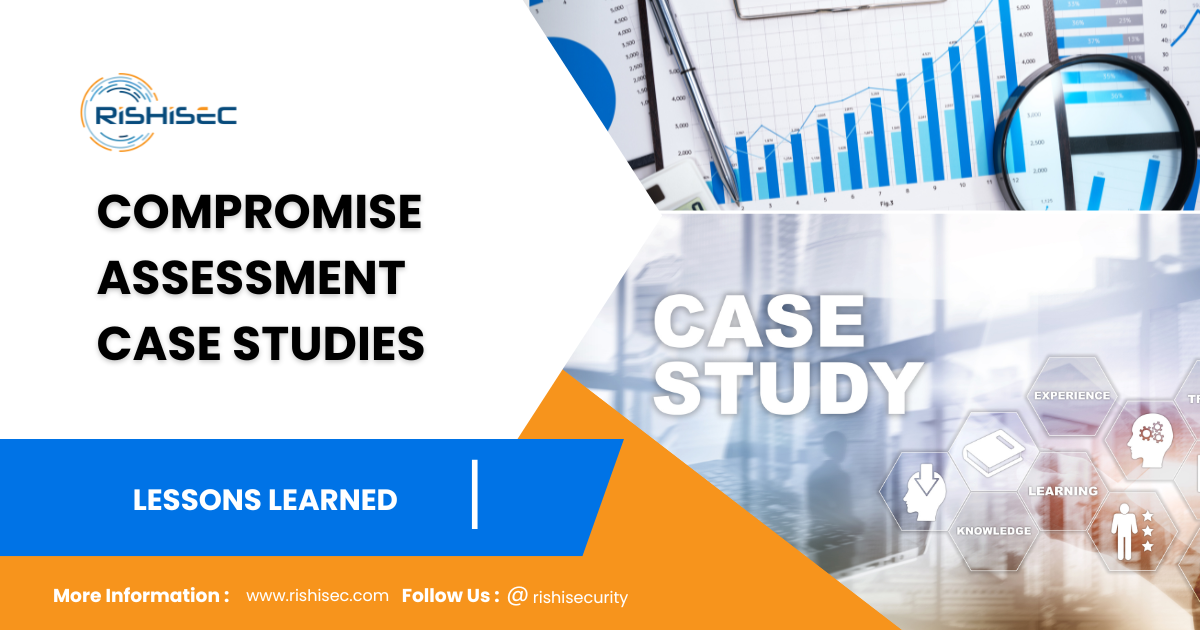Contents
- 1 Compromise Assessment Case Studies
- 2 1. Understanding Compromise Assessments
- 3 2. Case Study 1: Healthcare Sector Breach
- 4 3. Case Study 2: Financial Sector Attack
- 5 4. Case Study 3: Technology Company Ransomware Attack
- 6 5. Key Takeaways for Organizations
- 7 6. Conclusion for Compromise Assessment Case Studies
- 8 CTA
Compromise Assessment Case Studies
In today’s rapidly evolving cyber threat landscape, compromise assessments have become a crucial element of cybersecurity strategy. Because cyber threats continue to grow in sophistication, these assessments provide valuable insights into potential vulnerabilities and help organizations strengthen their defenses. By drawing from Compromise Assessment Case Studies, this post explores key lessons learned from various assessments. And it offers actionable insights to help you enhance your cybersecurity posture and better protect against future threats.
1. Understanding Compromise Assessments

Compromise assessments comprehensively evaluate potential security breaches within an organization’s IT environment. Unlike traditional security assessments that focus only on known vulnerabilities, these assessments uncover hidden threats already active within the system. Since such threats often go undetected, organizations must adopt a proactive approach. In addition, compromise assessments detect advanced persistent threats (APTs) and other sophisticated attacks that bypass standard security measures. By identifying these risks early, organizations can strengthen their defenses, protect critical assets, and minimize potential damage.
2. Case Study 1: Healthcare Sector Breach

Background
In a recent case involving a major healthcare provider, a compromise assessment revealed significant security gaps. Because the organization had experienced a breach that led to unauthorized access to sensitive patient data, the assessment was critical. So, it aimed to determine the full extent of the breach and identify any remaining vulnerabilities. Meanwhile, the organization began implementing temporary measures to contain the threat until more permanent solutions could be put in place.
Key Findings
- Inadequate Endpoint Protection: The assessment uncovered that many endpoints were not adequately protected, making them susceptible to attacks.
- Lack of Network Segmentation: The absence of proper network segmentation allowed attackers to move laterally within the network, exacerbating the impact of the breach.
- Delayed Incident Response: The organization’s incident response was delayed due to inadequate detection capabilities and a lack of predefined response protocols.
Lessons Learned
- Enhance Endpoint Security: Implementing robust endpoint protection solutions can significantly reduce the risk of initial compromise.
- Network Segmentation: Proper network segmentation can contain breaches and limit the spread of attackers within the network.
- Improve Incident Response: Establishing clear incident response protocols and improving detection capabilities can accelerate response times and minimize damage.
3. Case Study 2: Financial Sector Attack
Background
After noticing a series of suspicious activities suggesting potential insider threats, the financial institution launched a compromise assessment. The team identified unauthorized access points and traced how the attackers gained entry. They also uncovered remaining vulnerabilities that attackers could exploit in the future, ensuring the organization could address them proactively.
Key Findings
- Weak Access Controls: The assessment revealed that access controls were insufficient, allowing unauthorized users to access sensitive systems and data.
- Insider Threats: The investigation identified several instances of insider threats, where employees had misused their access privileges.
- Lack of Monitoring: The organization lacked adequate monitoring systems to detect anomalous activities that could indicate a breach.
Lessons Learned
- Strengthen Access Controls: Implementing stricter access controls and regularly reviewing access privileges can prevent unauthorized access.
- Monitor Insider Activities: Employing advanced monitoring solutions can help detect and mitigate insider threats before they escalate.
- Continuous Monitoring: Establishing continuous monitoring systems is crucial for detecting and responding to potential threats in real-time.
4. Case Study 3: Technology Company Ransomware Attack

Background
A technology company was targeted by a ransomware attack, and the attackers encrypted critical data, disrupting operations. So, to respond effectively, the company initiated a Compromise Assessment Case Study to understand how the attackers gained access and to evaluate the effectiveness of its existing security measures. This case study provided valuable insights. But it also revealed gaps in the security infrastructure, offering actionable recommendations to prevent future breaches. If the company follows these recommendations, it can significantly reduce the risk of similar attacks in the future.
Key Findings
- Phishing Attack Vector: The assessment revealed that the ransomware was introduced via a phishing email, exploiting human error.
- Inadequate Backup Systems: The company’s backup systems were found to be insufficient, making it difficult to recover from the attack.
- Poor Security Hygiene: The assessment identified several issues related to poor security hygiene, including outdated software and weak passwords.
Lessons Learned
- Phishing Awareness Training: Regular training and awareness programs can help employees recognize and avoid phishing attempts.
- Robust Backup Solutions: Implementing reliable backup solutions and regularly testing them can ensure data recovery in the event of an attack.
- Maintain Security Hygiene: Regularly updating software, using strong passwords, and implementing security best practices are fundamental to preventing attacks.
5. Key Takeaways for Organizations
Based on the lessons learned from these case studies, organizations should consider the following strategies to enhance their cybersecurity posture:
- Regular Compromise Assessments: Conducting regular compromise assessments helps identify and address vulnerabilities before they can be exploited.
- Holistic Security Approach: A multi-layered security approach, including endpoint protection, network segmentation, and continuous monitoring, is essential for comprehensive defense.
- Employee Training and Awareness: Regular training and awareness programs can significantly reduce the risk of human error and insider threats.
Want to read more about Cyber Security, Please read this post: Navigating the Cyber Security Landscape: Attack Surface Management vs. Vulnerability Management
6. Conclusion for Compromise Assessment Case Studies
Compromise assessments provide invaluable insights into an organization’s security posture and help identify areas for improvement. But learning from these assessments alone is not enough; organizations must act on the findings to address vulnerabilities effectively. And by applying lessons from Compromise Assessment Case Studies, they can further enhance their defenses and reduce the likelihood of future breaches. So, implementing a proactive approach to cybersecurity will not only improve your organization’s resilience but also ensure a more secure digital environment.
CTA
The lessons learned from these compromise assessments highlight how important it is to stay proactive and have strong cybersecurity measures in place. To protect your organization from growing threats and risks, it’s smart to add advanced tools to your security strategy.
Start improving your security today with SentryCA. Our powerful tools and expert services help you find weak spots, strengthen your defenses, and respond quickly to new threats. With SentryCA, you’ll get:
- Smart Threat Detection: Spot advanced attacks early with our top-tier detection tools.
- Complete Vulnerability Checks: Understand your security risks and fix problems before they’re exploited.
- Customized Solutions: Get recommendations that match your organization’s unique needs.
- Expert Guidance: Work with our cybersecurity experts to build and manage your security strategy.
Ready to protect your business and secure your digital assets? Request a free trial of SentryCA today and see the difference proactive security can make!


